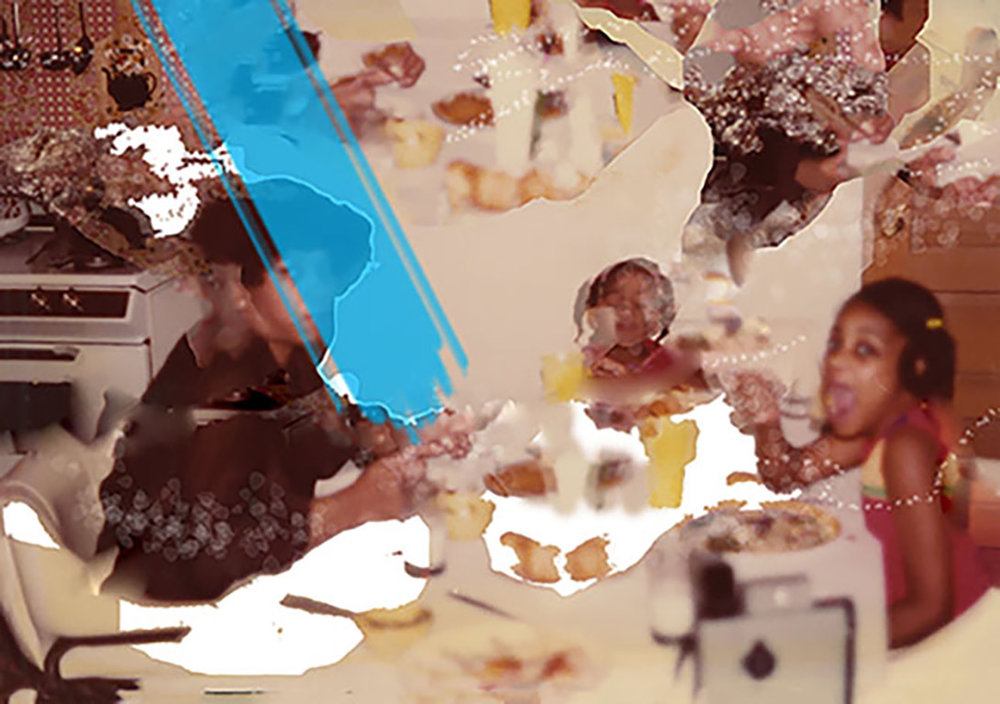Growing up in Chicago Heights, Andrea Coleman was surrounded by family stories. At turns humorous and devastating, that mythology is retold in her collage-like works, in which she digitally paints over old family photos with vibrant brush strokes. The 25-year-old artist's canvases depict major milestones, like weddings, to more quotidian moments, like eating dinner at the kitchen table.
Coleman’s work was on display all February at the Garrett–Evangelical Theological Seminary in Evanston, and her exhibition For Memory: These Are Deities in My Eyes will be on view at the Blanc Gallery until March 13. She'll participate in artist talks at each on March 4 and March 7 (time TBD), respectively.
What gave you the idea to combine mediums?
I'm predominantly a painter. During my senior year at Columbia, I had a project that I needed to get finished. I had a whole exhibition to set up and install the next day, and plan A had fallen through. I’d held on to one of these photos of my mom, and the photo looks exactly like me. I scanned it, then spent a whole night digitally manipulating it, because I didn't have time to paint a whole canvas.
Even though the style felt so intuitive and natural, I only had a vague sense of how it was done because I was sleep-deprived and mentally exhausted. To remember my process, I dove deeper into the history of my family and the image of my mother. Hearing the stories about the image from my mom, I began seeing the comparison in how I treated the image and why I distorted the image in the first place.
What does it mean for you to combine mediums rather than strictly photography or strictly painting?
I wanted to resurrect these images that were stuffed in an old photo album and enlarge them because their subjects were monumental figures to me. The stories of my ancestors and family members are the foundation of myself.
I was essentially painting in [collage] already; I just wasn't doing it digitally. The way the photos needed to be treated could not be done by hand. As I was making my pieces, I realized it was mostly like a copy over a copy over a copy, with fragmentations and blank spots — certain information I will never know about these people, even though I've known them for so long.
Has your artistic process changed since you were at Columbia?
The process is much quicker than when I was in school. I've always struggled with, “Am I a photographer or am I a painter now?” I just eradicate all of those titles by saying I'm a storyteller. I'm an artist with stories. I'm not looking for validation from anyone else because these are personal, intimate situations of people in my life.
I used to think my work was invalid because there was no paint added. But now I know it's more important than any of the work I've done beforehand because it represents a universal family experience through the lens of black experiences.

On Instagram, you said that the pieces at your exhibit at Garrett–Evangelical Theological Seminary have “undergone a continuous transformation through different environments that [they] occup[y].” How have your pieces changed over time?
In Evanston, no one's ever seen my work. I wanted to take it to another demographic — students in a Catholic setting — and introduce the black experience. The curator said people were amazed because they never had large pieces like that displayed in that area.
Everyone has a photo album. But people were stopping to say, “Well, I know what this is.” Even though I can explain to you how I feel at the moment, my work would evoke different feelings within someone. I felt like I did my job because these pieces are very universal in that way, regardless if they're about my family in particular.
What story do you hope your work tells to someone who's looking at it?
My story talks about mental health, about the trauma that’s within families — especially black families and black experiences. I wanted to highlight that because I've never really seen a black family put up in a museum or an exhibition.
There are a lot of mental health issues or trauma that my family has experienced that I don't think has been told. The story may never be told, but you can see it within these images. I'm pretty sure everyone else has a family member that has a lot of stuff going on that they can't really disclose. This is how I express their voice.




